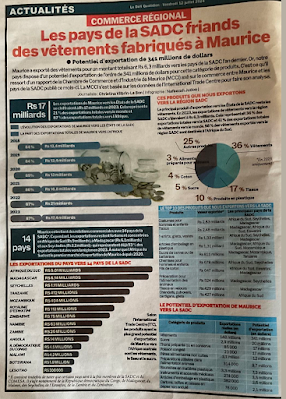Government’s export boom narrative is nowhere to be seen in the statistical data. After a negative growth of 12% in 2023 , the export of goods is expected to register another year of negative growth , a -1.7 growth in 2024 . In real terms (on the basis of latest historical series on SM’s website-not updated), it is just Rs 67 bn compared to pre-pandemic level of Rs 77 bn-still 88% of the 2019 level of exports of goods. The secular deterioration in our capacity to meet import needs from export earnings is reflected in the declining ratio of exports to imports of goods (both on FOB basis) from around 60% a decade ago to less than 40% currently.
We continue to fail in boosting the growth of exports of goods and diversify our exports basket ;for the past ten years, we have neither developed more products of global standards (at competitive prices) nor explored new markets and we have not fully exploited the CECPAs and FTAs with trade-positive economies.
Have a look at the the attachment below titled 'Commerce Régional” published in today’s Le Défi. It shows our exports potential to SADC countries in some products as worked out by the International Trade Centre.
This is the type of work that the EDB and the International Trade Division(ITD) at the Ministry of Foreign Affairs should be doing to help in boosting and diversifying our exports especially for the SME sector…
The EDB seems to be more successful in attracting investment in PDS, IRS and Smart cities and in the bétonnage of the country …
Our whole exports and SME sector need a beefing up in terms of a more proactive competitive strategy to enable the sector to upgrade itself, become internationally more competitive and secure a growing share of regional and world trade…
We need a new technology strategy to address specific needs of innovation and technology diffusion in the EOEs and SMEs.
EDB’s export promotion tours and road shows are not properly accompanied by regular follow-ups ….and it is mostly a waste of resources. That’s why we think that the setting up "Trading Houses" in key COMESA/EAC and SADC regions must be re-examined with greater focus on providing a shop front, warehousing facilities, marketing services, selling bulk and breaking bulk and taking orders for Mauritian products.
Export market information requires urgent attention. The trading houses will also enable global knowledge acquisition-acquiring crucial market knowledge, finding the right people, firm and institution, building the contacts for insightful information and leads. It will also influence the ways our business sells and markets our brand, builds relationships, secures resources and negotiates the best deals and partnerships for our exports and SME sector.
Promotion of international and strategic partnerships: Significant opportunities exist for Mauritius to leverage its close ties with the regional blocs such as SADC and COMESA/EAC and the powerhouses, India and China, to mount joint ventures in Africa. Mauritius will need to put in more efforts in steering its policies towards a more consistent trade, regional and global strategy which is part and parcel of our responses to the global challenges and new developments.
The import profile of Africa shows that there is large demand in the region for a variety of products: pharmaceuticals, frozen fish, cotton yarn, small parts of machinery, processed foods, auto components, soya bean oil, electronic components, etc.
Partnership with India and China will allow Mauritian SMEs and exports sector to gear themselves to take advantage of these business opportunities and the new ones like electric cars, solar power and wind power. EDB and the ITD will have to refocus their FDI strategies to promote such international and strategic partnerships.
